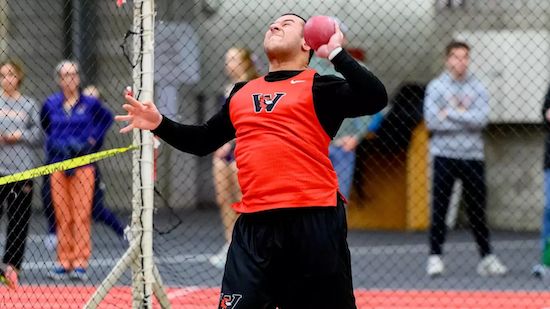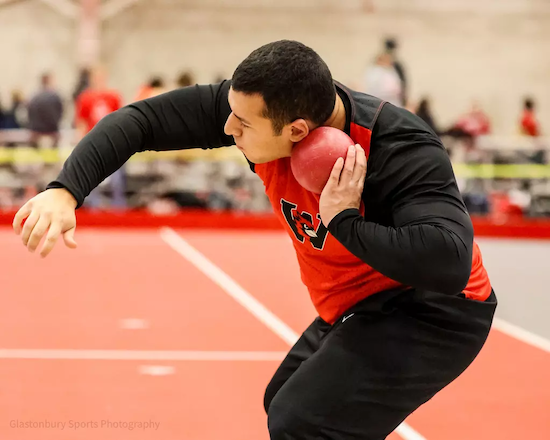
c/o Steve McLaughlin
In Play(er) of the Week, our goal is to highlight outstanding athletes or moments from games that deserve extra attention.
Javier Orellana ’25 is a psychology major and data analysis minor from East Islip, N.Y. and is a thrower on the Wesleyan men’s track and field team. In his senior year with the Cards, Orellana has gotten off to a great start, with fantastic indoor season performances all winter long. On Jan. 17 at the NYC Gotham Cup, he broke the school record for men’s indoor shot put, throwing 15.03m and placing third overall in the event. The record was held for 10 years in the Red and Black history books before Orellana finally beat the mark. He extended his record at the Springfield Triangle Invitational on Feb. 22, where he threw for an event-winning 15.23m. He now looks forward to chasing the outdoor shot put record, which he’s been gunning for since he arrived his first year. The Argus sat down with Orellana to discuss his beginnings in track and field, breaking the indoor record, and future team aspirations.
The Argus: When did you start competing in track and field?
Javier Orellana: Around my junior [year of] high school. I started as a sprinter, but since then, I’ve put on some weight, and I was feeling somewhat strong, so I was like: “Let’s get throwing a shot.” In the spring semester of junior year [of high school], I first competed. I was pretty good. I decided I’ll keep going with this, and since then, now I’m here.
A: Did you play any other sports growing up?
JA: I was big into baseball. I don’t know exactly how well the skills converted, but the idea of throwing was something so natural to me. So I was like, “Let’s start throwing in track.” Obviously, [they are] different motions and didn’t fully convert, but it was still just as much fun.
A: What’s the biggest difference between track and field at the high school level compared to the college level?
JA: Obviously, the level of competition is completely different. But a lot of the people I’ve met, especially in the NESCAC area, are great competitors, but they’re also really nice people, and we all always root for each other in meets. We just recently had our NESCAC invite for indoor, and it was a lot better vibes than any other meet you go to.
A: Do you have any track and field inspirations or athletes that you look up to?
JA: I was always a big baseball guy, and I loved watching a lot of the Dominican players. They put in so much work, and so I tried to adopt my work ethic […] [to involve] constantly putting the work in until I’m exhausted. But like Juan Soto, I know Ryan Crouser is the obvious one for throwing. Watching him is so much fun whenever I can.
A: Do you just do shot put for Wesleyan? Do you do other events, or are there other events you have done throughout your track and field career?
JA: Originally, I did shot [put] and weight [throw] in winter. I decided I wanted to stick with shot, because that motion is the most natural to me, and I wanted to hone in on one thing. When I started here, I really focused on wanting to break that school record. And so I’ve found myself at this point where I have broken it for indoor and I’m still focusing because the outdoor one is both older and moderately farther. I’m still focusing on trying to beat that.
A: It always feels like athletes in field events form a strong bond with each other, considering you all are competing in similar events that may require similar mechanisms. What is the chemistry like with the field athletes, the throwers, and the team as a whole?
JA: It might be the best you can get. It would be a completely different experience without them. They’re there for almost all of my training, and they’re a big part of the reason that I’ve put so much energy into it.
A: The biggest reason why you are getting our Player of the Week is for your school record-breaking performance at the NYC Gotham Cup over winter break, where you shattered the indoor shot put record that was held for a decade. You mentioned you’ve been hunting down that record for a while: How did you find out you broke the record?
JA: So, of course, I was looking at it throughout my years here. It’s on the track website, and it’s on the big board that you see when you go into the field house. So it was just a reminder every time I passed by, and I’ve honed in on that number. So when I got to the Gotham Cup, I was focused on just beating the number. When I heard, I was like, “Finally!”
A: You mentioned, obviously this record is great, but you’re also looking forward to trying to break the outdoor record as well?
JA: Yeah, so I’ve been continuing my training. Now I’m trying to extend the record I have now [in indoor] and then, when we get to outdoor, be at a point where I could get [the outdoor] record and extend it a little further as well.
A: What is a difficult part of being a field athlete that the average person would underestimate or not think about?
JA: The one part that sucks is at the meets, you gotta wait like seven hours. One time, I had to wait a full eight hours before I threw, so I felt like a whole day went by. In terms of training, there’s a lot of wear that goes down on specific parts of your body. For me, it’d be my hands, and then also you could still get shin splints and stuff like that from not running, and the continuous pushing motion, that wears down as well.
A: How difficult is it to manage the student-athlete balance at Wesleyan?
JA: My first few years, it was very difficult. I was taking a lot of challenging classes, [and there were] a lot of studying hours I had to put in overnight that took away a little bit from my sleep. But I’ve been able to balance it, and a lot of professors and TAs have been great with helping me through it. I couldn’t ask for a better supporting cast throughout my years.

c/o Steve McLaughlin
A: As a senior on the team, what lessons do you try to teach your younger teammates that you’ve gained over your collegiate career?
JA: The one in specific would be to pace yourself. In track, we don’t have nearly as long of a season as cross country, but we still have winter and spring, and that wears you down, especially if you’re taking so many practice throws a week.
A: Looking back on what has been an impressive career at Wes, what are you most proud of, both something that does show up on the stat sheet and something that doesn’t?
JA: Obviously, the record would be the number one thing for me, but also the friends I’ve made. I know that I’m really close to the track team. I have lived with them for a couple years now, and they’ve been great. Especially my senior class, I’m very close with them, and I’m probably going to keep talking with them, traveling with them, and doing as much as I can with them for years to come.
A: As you all finish the indoor season and prep for the spring, what should people be excited about with Wesleyan track and field?
JA: This is not gonna sound great, but my first couple years, we’ve obviously had a lot of individual success. We’ve had Grace Devanny [’23] being National Champion [in indoor 400m dash]. I’ve made All-NESCAC [teams], and we’ve had a couple others also make All-NESCAC, from both men’s and women’s. But we haven’t seen a lot of overall team success. I think something the coaches have been doing really well is building up our depth on our team. So, seeing us become actual competitors in the NESCAC Championship is going to be great.
This article has been edited for length and clarity.
Max Forstein can be reached at mforstein@wesleyan.edu.